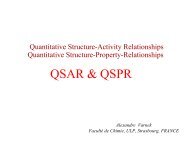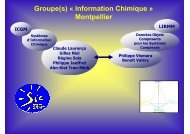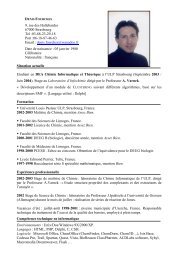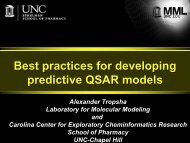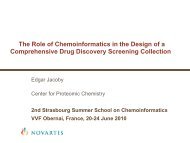International Summer School PROGRAM - Laboratoire d'Infochimie ...
International Summer School PROGRAM - Laboratoire d'Infochimie ...
International Summer School PROGRAM - Laboratoire d'Infochimie ...
Create successful ePaper yourself
Turn your PDF publications into a flip-book with our unique Google optimized e-Paper software.
Silica Nanoparticles with Proton Donor and Proton<br />
Acceptor Groups: Synthesis and Aggregation<br />
Gorbachuk Vl.V., Meleshina M.V., Yakimova L.S.,<br />
Antipin I.S., Stoikov I.I., Zharov, I.<br />
Kazan (Volga Region) Federal University, 18 Kremlyovskaya St., Kazan,<br />
e-mail: vladimirgorbachuk@gmail.com<br />
Silica particles attract much attention due to their useful properties, which open numerous<br />
opportunities for the preparation of functional nanomaterials. Functionalized silica particles are<br />
relatively easy to prepare in a wide range of sizes and morphology, they can be functionalized with<br />
various organic groups, and possess high stability. Materials based on these particles have unique<br />
mechanical, thermal, optical, electronic and biological properties and find application in catalysis,<br />
drug delivery, sensors, etc.<br />
The effects of precursor structure and polycondensation conditions on the properties of hybrid<br />
nanoparticles synthesized from organo-trimethoxysilanes were studied. Hybrid nanoparticles<br />
containing groups capable of forming hydrogen bonds were synthesized from functional derivatives<br />
of 3-aminopropyltrimethoxysilane.<br />
We have demonstrated that all these nanoparticles form aggregates in solution, and that the size of<br />
these aggregates depends on solution pH, ionic strength and solvent polarity. Therefore, by changing<br />
the pH of the solutions, it is possible to control the size of the nanoparticle aggregates. For<br />
phenylurea-functionalized nanoparticles, three different synthetic methods have been used, allowing<br />
to relate the composition of these nanoparticles to their aggregation behavior.<br />
. Structures of obtained compounds and particles were characterized by NMR-, IR-spectroscopy,<br />
mass-spectrometry, elemental analysis and combined TG-DSC. Aggregation behavior was studied<br />
by DLS and AFM methods.<br />
Acknowledgments: The financial support from RFBR (10-03- 92661-NSF), the Program of the<br />
President of the Russian Federation for the State support of young Russian scientists—Candidates of<br />
Sciences (MK-6390.2010.3) and NSF MWN grant (DMR-1008251) is gratefully acknowledged.



